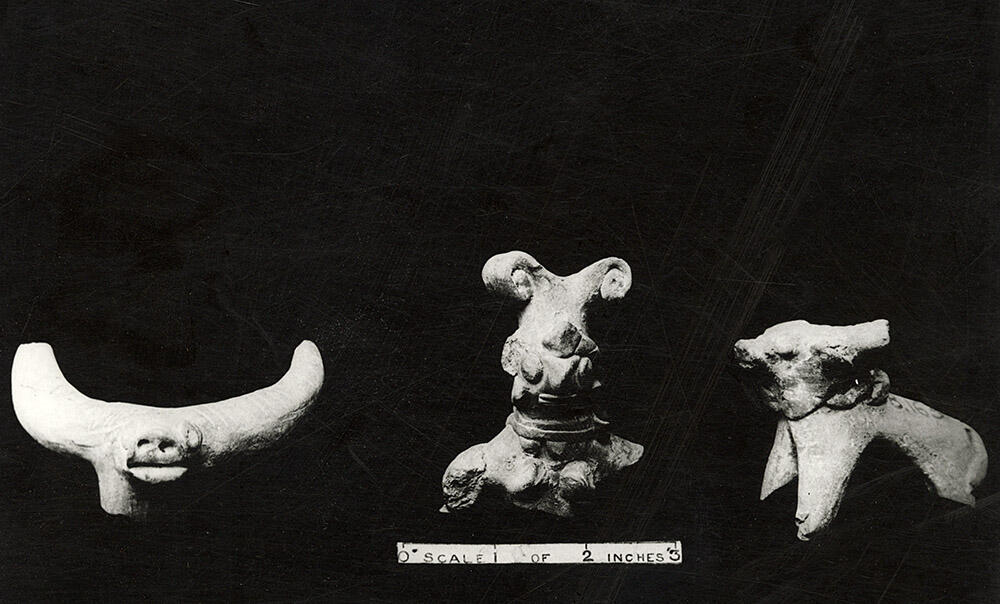Smaller items start getting grouped for the photographs, in photographs from subsequent years we start to see many more objects grouped in each image.
[1] Terracotta head, left. Terracotta bull, right.
"Harappa offers a greater variety of animal figures than those yet published from Mohenjo-daro. By far the largest number of these pottery toys are bulls, the humped variety preponderating over the humpless ones."
- Madho Sarup Vats, 1940. Excavations at Harappa: Being an account of archaeological excavations at Harappa carried out between the years 1920-21 and 1933-34. Volume I - Text; Volume II - 139 Plates., pp 300-301.
[2] Female bust, centre
"A very large number of human figurines has been found at Harappa at all levels and in all trenches. Nearly two-thirds of them are female and over one-third male, the latter not being so rare as at Mohenjo-daro. The female figures wear only a loin cloth with or without a girdle. The male figures...are all nude. Usually, the female figures are standing but they are seen in several other postures also, while the male are commonly found seated, either with their arms round the knees, or in a devotional attitude with hands folded and the legs in front.
Most of the human and animal figures, retain no trace of paint, and it is probable that three-fourths of them were never painted at all, though weathering and the action of saltpetre in the soil may account for the disappearance of the paint from a number of them. As at Mohenjo-daro, the colours used were haematite and yellow' ochre for red, and green earth for green. Now-a-days, too, red lead (sindhura}, or red ochre (geru), mixed with water or oil (not with ghi) is applied to sacred images of gods and goddesses as well as their vehicles.
As already pointed out by Dr. Mackay in M. I. C., many of the female figures wear a distinctive head-dress which rises fan-like from the back of the head, in some cases directly from the head...while in others it forms part of the coiffure...Another peculiarity of these figurines is a shell-like object worn on either aide of the head sometimes supported by a band or braid of hair...Sir John Marshall suggests that these may in reality have been distended ears, the ears having been artificially enlarged and shaped to the form of a hollow shell or cup. Above the forehead and in front of the fan-like head-dress several figures wear flowers (usually three) in the head-dress....
As at Mohenjo-daro, most of the female figures wear an abundance of jewellery. Among the most common ornaments are a close-fitting collar with a number of pendents, a long necklace, often with a brooch or clasp at the centre, reaching down between the breasts, and a loin girdle, with one to three bosses or clasps. Among the male figurines, jevrellery is rare.
Of most of the figures the arms and lower legs are broken, and any armlets, bracelets, or anklets that they may have worn, have disappeared.
All pottery figures are well burnt and are usually of a dull red or flesh colour. The technique regarding their eyes, nose, mouth and ears, which is identical at Harappa and Mohenjo-daro, has already been fully explained by Dr. Mackay and does not call for further discussion.
- Madho Sarup Vats, 1940. Excavations at Harappa: Being an account of archaeological excavations at Harappa carried out between the years 1920-21 and 1933-34. Volume I - Text; Volume II - 139 Plates., pg 292.
The head of a terracotta water buffalo figurine shows the wide curving horns with distinctive grooves. The central figurine is of a woman with a conical head ornament in the middle of the forehead that is similar to hair ornaments called “tika” used in Northern and Western South Asia today (both India and Pakistan). The figurine on the right is also a water buffalo figurine with a possible ornament or harness around the neck.
- Jonathan Mark Kenoyer, 2023.
[Original caption] Terracotta bull, female bust and bull heads

